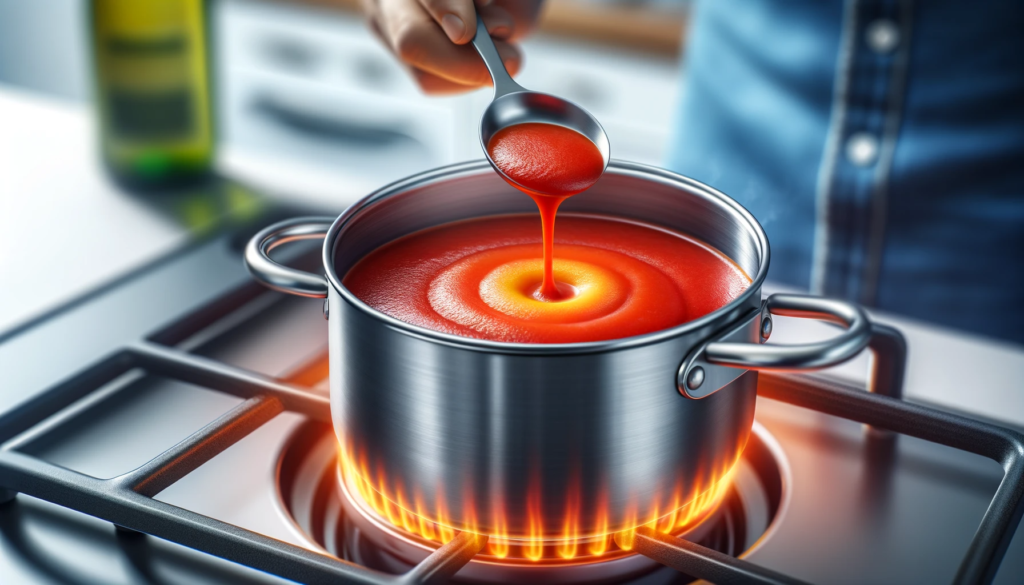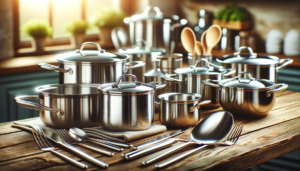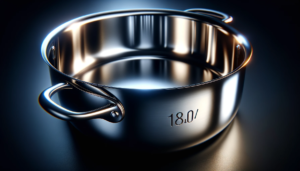Does your stainless steel cookware secretly add minerals like chromium to your diet? Despite alarming headlines, the answer is more benign than you might expect.
Research shows that while tiny amounts of chromium can migrate from stainless pans and pots during cooking, the quantities are negligible compared to dietary intakes from healthy foods.
Let’s examine what stainless steel cookware is, whether it increases chromium exposure, how much we need, and expert tips on safe usage.
What is Stainless Steel Cookware?

Stainless steel cookware refers to pots, pans, and other cooking vessels that are made from steel alloys containing chromium.
The addition of chromium creates a passive layer of chromium oxide on the surface that prevents rusting and staining, making the cookware more durable, non-reactive, and low maintenance compared to other materials like aluminum or cast iron that can react with acidic foods.
There are different grades of stainless steel cookware designated by numbers like 18/8, 18/10, 18/0 etc.
The first number refers to the percentage of chromium in the alloy, while the second number is the percentage of nickel.
So an 18/8 grade stainless steel contains 18% chromium and 8% nickel content.
The nickel enhances corrosion resistance and stability.
Higher nickel content generally indicates better quality stainless steel that is more resistant to damage or breakdown.
What is Chromium?

Chromium is a metallic element and an essential trace mineral needed by the human body in small amounts.
It assists with the proper metabolism of carbohydrates and fats.
Chromium also helps maintain stable blood sugar levels already in normal range by enhancing the effects of insulin.
Supporting healthy insulin function may also provide benefits for weight management in some individuals when combined with balanced nutrition and an active lifestyle.
The recommended adequate intake for chromium is 20-35 micrograms per day for adults over the age of 19, with increased needs for adolescent development and pregnancy.
Good food sources that provide chromium include meats, organ meats, cheese, whole grain products like bread and cereal, broccoli, nuts, green beans, eggs, and egg yolks.
By consuming a balanced diet containing these foods, most people easily meet their chromium needs through dietary sources alone.
Supplements are rarely necessary, except potentially in cases of deficiency related to restrictive diets, medical conditions, or underlying nutritional problems.
Does Stainless Steel Leach Chromium into Food?

There is always a small possibility with any metal cookware that tiny amounts of the metals used can migrate into food during the cooking process through normal chemical reactions enhanced by heat, moisture, and acids.
However, numerous studies have conclusively demonstrated that the minute amount of chromium released from quality stainless steel pots and pans during typical cooking is negligible compared to the average dietary intake from regular foods.
Various research studies measuring metal leaching under different cooking conditions like boiling tomato sauce for an hour invariably show that any chromium absorbed from stainless steel cookware is insignificant compared to recommended intake levels or health requirements.
While factors like high heat and acidic ingredients can increase the small migration of metals like chromium slightly, the cumulative amount transferred even under extreme conditions is still hundreds or thousands times lower than the amount needed in the body from dietary sources for good health.
Other Sources of Dietary Chromium
While the negligible potential exposure from stainless steel cookware draws attention from some health-conscious consumers, experts explain that any tiny amounts potentially transferred are dwarfed by far greater amounts of chromium readily obtained eating common foods like broccoli, grapes, meat, eggs, whole grains and cheese.
Just one single serving of broccoli can supply over 20 micrograms of highly absorbable chromium – more than double or triple the maximum amounts estimated to migrate out of stainless steel cookware into food during even vigorous extended boiling or braising.
For most people trying to obtain adequate chromium and other essential trace minerals, selecting different non-stainless cookware would have little to no meaningful effect compared to simply including more mineral-rich fruits, non-starchy vegetables, quality proteins and whole grains as part of a varied, balanced diet on a daily basis.
In contrast, those following severely restrictive fad diets almost completely deficient in plant foods containing chromium could potentially get a modest mineral boost from stainless steel cookware.
Is Chromium from Cookware Harmful?

Despite the confirmation that only trace amounts of chromium can migrate from stainless steel cooking pots and pans into food during preparation, extensive research has found no evidence this miniscule exposure poses any substantial harm or noticeably increases disease risks, even for healthy individuals over a lifetime of regular cooking.
In fact, the estimated daily intake calculated from cookware is still thousands of times lower than established safety limits for chromium and substantially lower than naturally occurring levels common in foods most people eat daily without issue when consuming a reasonable diet.
On the other hand, lower grades of stainless steel alloys containing less protective chromium and nickel do allow for markedly higher leaching far above typical dietary intakes.
Over years or decades, such elevated exposure could potentially impact health much more dramatically.
However, sticking with high-quality stainless steel cookware utilizing iron alloys with enough 18% chromium and 8+% nickel provides maximal corrosion protection that restricts metal migration to safe, negligible levels during all but the most extreme, unrealistic cooking scenarios.
Tips to Limit Exposure

While credible experts nearly unanimously agree the miniscule chromium absorbed from quality stainless steel poses no realistic or rational threat, those still concerned about exposure have a few options to further minimize even this trivial risk:
- Use nickel-free stainless steel cookware with iron alloys containing 18% or higher chromium whenever possible for maximal corrosion protection to restrict metal leaching.
- Avoid prolonged boiling or simmering of very acidic liquids like lemon juice, tomato sauce, wine, or vinegar.
Limit acidic cooking times to no more than 30 minutes. - Don’t leave empty stainless steel pots or pans sitting over very high direct heat for long periods.
- Consider glass, ceramic, enameled, or pure titanium cookware for certain types of food prep when looking to minimize all metal usage in cooking.
However, experts universally explain that the tiny levels of metals naturally transferred from quality stainless steel cookware are inconsequential compared to the far higher dietary chromium intakes from eating ordinary healthful foods like vegetables, fruits, nuts, whole grains, cheese, yogurt and meat as part of a reasonable balanced diet focused on plant foods and lean proteins.
While sensible precautions can further restrict exposure from cookware, emphasizing a varied nutrient-rich diet remains most vital for obtaining beneficial minerals over the long term.
Conclusion
While small amounts of chromium may leach into food from stainless steel cookware, extensive research confirms this minute exposure is trivial compared to the much greater amounts obtained from a balanced, mineral-rich diet.
By choosing high-quality cookware and emphasizing nutritious whole foods, consumers can obtain adequate chromium without concern.



